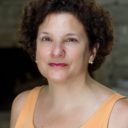A dancer, muscular and magnificent, closed the Opening Plenary on the first day of the Philea conference in Barcelona. The music, the beat, and the pace energised us as we began more traditional ways of learning, through workshops and lectures.
Art was everywhere at the Philea conference. I loved every moment.
One reception was held at the jaw-dropping Hospital de Sant Paul, the largest Art Nouveau setting in the world. Every corridor, surgical theatre, and patient room was filled with mosaics. What must it have been like to receive medical care at the 600-year-old hospital, or to be a nurse, doctor, or janitor there, surrounded by beauty?
Another reception was held at the CosmoCaixa. Like STEM students, we walked through this enormous, engaging science museum. As a finale to the evening, two ballet dancers performed parts of the Nutcracker Suite—poised high on the sides of the outer walls of the museum itself. Who among us was not astonished to see the dancers, whose core strength and balance must have been extraordinary, perpendicular to the walls?
I certainly reflected for days on who thought up such an exercise—that a dancer with the help of a slim brace of fabric, could dance, perpendicularly, on the side of a building.
Some of us enjoy art, some of us make art, and some of us claim the title ‘artist.’ Some of us contribute to the arts financially, or support it through our fundraising efforts. How wise that Philea includes arts in its programming. Whether we are observers of art or creators of art, art has a significant role to play in strengthening our resolve, clarifying our thinking, and inviting our creative problem-solving. It spurs conversation as it enables us to look at something in a fresh way.
What is it about the arts that empowers our difficult work in creating a better world through philanthropy? Why do we include it in our work lives, if and when we do? I often feel that art in my professional life opens countless possibilities for me to see clearly and creatively on complex problems or issues.
Of course, art’s purpose is not a means to an end. In an enlightened society, we do not need art for the purpose of advancing our work. I am glad that Soviet realism, its posters of workers in the fields or factory, has a place only in museums as a part of history, for example. But even those posters are rich with beauty and perfection to every viewer.
The Athena Advisors, a consulting firm which I lead, has an Artist in Residence program. This enables our clients to have the benefits of the arts. We also offer a program every-other-month open to anyone. People from Illinois, Paris, London, Washington, D.C., and Toronto drop in to ‘make marks’ for an hour, on such themes as beauty, mentoring, harvest, bridges. Eleni Zatz Litt, Ph.D., a social anthropologist trained at the London School of Economics, guides us through a light hour of focus and depth. Our next workshop is June 29, see the event here on LinkedIn.
One of the attendees who leads a fundraising team for a humanitarian organization in Paris, told me that her husband called it ‘art therapy’—incorrectly, we both acknowledged with a smile. This kind of applied art which is hands-on invites our ease and our openness. It is offered not as an ‘intervention,’ but as a way to bring the complete person to the work day.
And our work—this work of philanthropy—deserves all our talents, creativity, and strength.
I am reminded of those dancers on the side of a building at the Philea conference. I imagine what it took to build enough core strength and confidence to dance gracefully on the side of a building in front of an audience of 800 people. They make it look easy, just like we make it look easy to do our hard work, with grace, of building the resources to create a better, more just, more beautiful world for all.
Robin Heller is President The Athena Advisors






Comments (0)